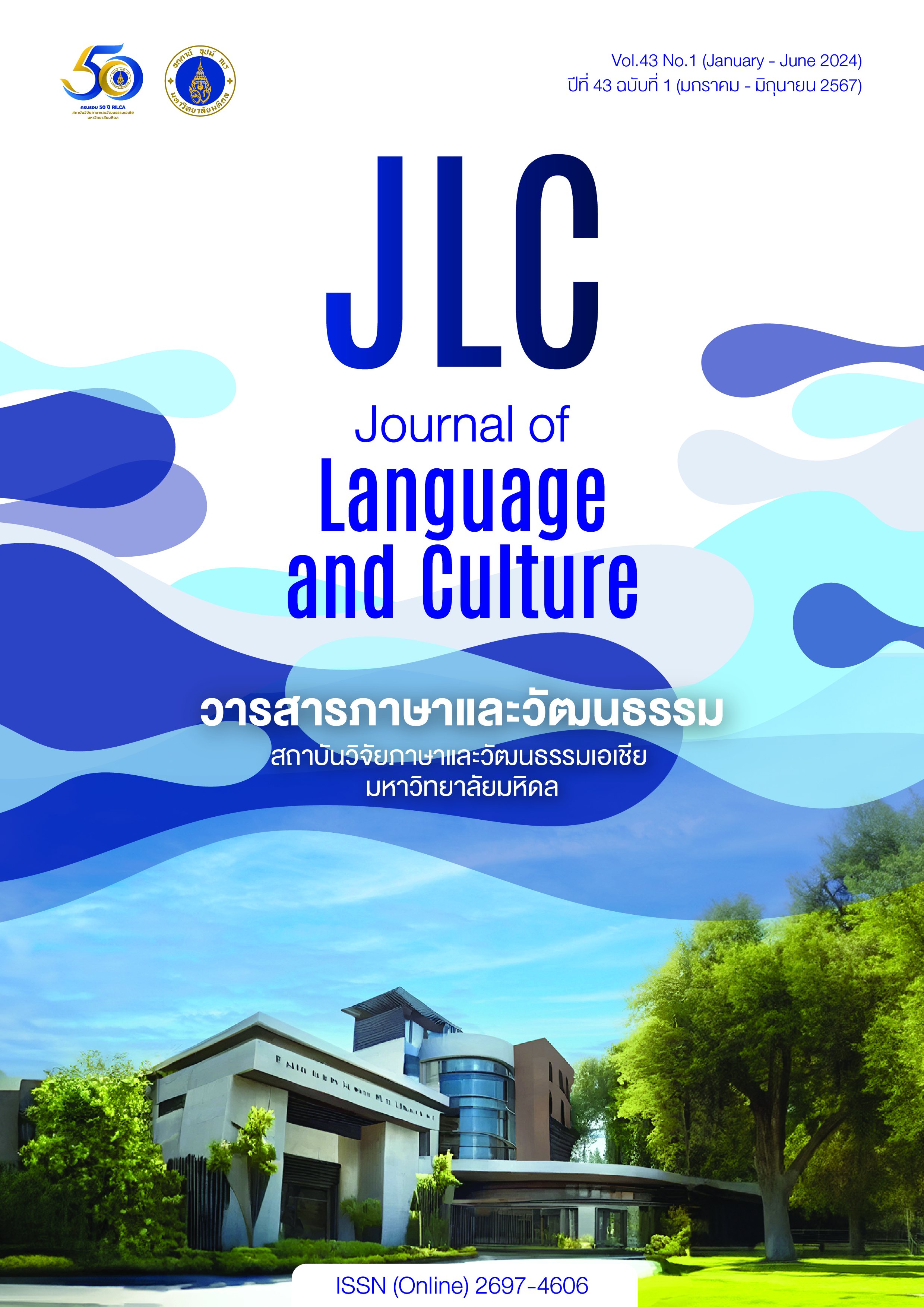English loanwords in Thai new word dictionary: A reflection on society
Main Article Content
Abstract
The latter part of the 21st century is widely recognized as an era where communication technology significantly shapes access to information and the absorption of foreign cultures. This trend is evident in the increased usage of English loanwords. An examination of English loanwords featured in the Royal Institute’s New Words Dictionary, Volumes 1-3, reveals three primary methods of integration: transliteration, translation, and coinage. Transliteration involves adapting English words to fit the Thai language system while retaining their original form or adjusting them to adhere to Thai pronunciation principles. Translation, on the other hand, entails rendering English words or phrases into Thai equivalents. Coinage refers to the creation of entirely new Thai words with similar meanings. Comparing the meanings of English loanwords in the new Thai dictionary with those derived from English sources (The Cambridge Dictionary available at https://dictionary.cambridge.org) reveals significant changes from the original meanings. These alterations range from narrowing to broadening and sometimes even completely transforming the original meaning. In the vocabulary section, the dictionary of new words primarily focuses on words related to intelligence, emotions, and values. It encompasses terms associated with the mind, emotions, feelings, thoughts, and values, collectively constituting the majority of the vocabulary. An analysis of English loanwords in the dictionary underscores substantial shifts in meaning, indicating the evolving nature of language and its impact on societal comprehension and communication.
Article Details

This work is licensed under a Creative Commons Attribution 4.0 International License.
The articles featured in the Journal of Language and Culture (JLC) constitute academic works representing the viewpoints of the respective author(s). It is crucial to note that these opinions do not necessarily reflect those of the Editorial Board.
All articles published in JLC are released under the Creative Commons Attribution 4.0 International License (CC BY 4.0). This license grants permission for unrestricted use, distribution, and reproduction in any medium, provided proper credit is given to the original author(s) and the source.
References
Bandhumedha, M. (2003). ภาษาต่างประเทศในภาษาไทย. [Foreign Languages in Thai].
Department of Thai and Eastern Languages, Faculty of Humanities, Ramkhamhaeng University.
Bilyamae, N. & Prasatkaew, S. (2020, December 17-18). ภาพรวมของวิทยานิพนธ์ไทยที่ศึกษาเรื่องคำยืมภาษาต่างประเทศในภาษาไทยระหว่าง พ.ศ. 2528-2556 [Overview of Thai Theses on Loanwords in the Thai Language from 1985-2013]. [Paper Presentation]. International Academic Conference on Interdisciplinary Collaboration in Academic and Cultural Aspects Among Four Educational Institutions, Thailand.
Borisuth, P. (2011). พจนานุกรมคำใหม่ ฉบับราชบัณฑิตยสถาน เล่ม 3 [The Royal Institute Dictionary of New Words, volume 3]. Nanmee Book Publishing.
Butte, S., & Singsawat. P. (2019). การเปรียบเทียบคำยืมภาษาอังกฤษในพจนานุกรมฉบับราชบัณฑิตยสถาน พ.ศ. 2554 กับพจนานุกรมฉบับมติชน [Comparative English Loanwords in the Royal Institute Dictionary 2011 and Matichon Dictionary].
Journal of Man and Society, 5(1), 101-123.
Chonmahatrakul, N., & Onsuwan, C. (2016). การศึกษาการเติมเสียงวรรณยุกต์ให้กับคำยืมภาษาอังกฤษแบบทับศัพท์และระบบการสะกดคำยืมในภาษาไทย. [A Study of Tone Assignment in English Loanwords and Spelling System in Thai]
Journal of Liberal Arts Thammasat University, 16(1), 71–89. Retrieved from https://so03.tci-thaijo.org/index.php/liberalarts/article/view/64200
Gaidatzi, T. (1985). Greek loanwords in English [Master’s thesis, University of Leeds]. Repository.https://www.academia.edu/31644852/GREEK_LOANWORDS_in_ENGLISH
Haspelmath, M. (2009). Loanwords in the World’s Languages. In Martin Haspelmath and Uri Tadmor (Eds.), Lexical borrowing: Concepts and issues (pp. 35-41). https://doi.org/10.1515/9783110218442
Jiaphong, S. (2022). คำยืมภาษาต่างประเทศในพจนานุกรม ฉบับราชบัณฑิตยสถาน: การศึกษารูปแบบคำและการจำแนกประเภทความหมาย [Foreign Language] Loan Words in Royal Institute Dictionary: A Study of Word Forms and Semantic Categories]. Mekong-Salween Civilization Studies Journal, 13(1), 96-120.
Kingkham, W. (2007). ภาษาต่างประเทศในภาษาไทย [Foreign languages in Thai]. Kasetsart University Press.
Kingkham, W. (2013). ภาษาต่างประเทศในภาษาไทย (พิมพ์ครั้งที่ 2).[Foreign languages in Thai]. (2nd ed.). Kasetsart University Press.
Krasaesin, Y. (2016). ความคิดเห็นเกี่ยวกับวิธีการบัญญัติศัพท์ [Comments on how to coin terminology] Vannavidas, 2, 148–153. https://doi.org/10.14456/vannavidas.2002.13
Kullawanich, P. et al., (1992). ภาษาทัศนา [Visual language]. Chulalongkorn University Press.
Phokasamrit, P. (2021). การใช้ภาษาอังกฤษในภาษาพูดของไทย [Use of English in spoken Thai]. Journal of the Faculty of Arts, Silpakorn University, 3(2), 54–64.
Prasithrathsint, A. (1997). ภาษาในสังคมไทย : ความหลากหลาย การเปลี่ยนแปลง และการพัฒนา [Language in Thai Society: Diversity, Change and. Development]. Chulalongkorn University.
Prasithrathsint, A. (2006). พินิจไทยไตรภาค ปฐมภาค : ภาษา. [Thai Language Tripartite Review: First Volume: Language]. Thai Studies Institute, Chulalongkorn University.
Saelee, S. (2013). การออกเสียงวรรณยุกต์ในคําทับศัพท์ภาษาอังกฤษในภาษาไทย [Tone Production of English Loanwords in Thai]. Journal of Liberal Arts, Thammasat University, 13(1), 17-32.
Santikul, O., & Chaiyapanya, J. S., (2017). การเปลี่ยนแปลงวงศัพท์ของคำทับศัพท์ภาษาอังกฤษในพจนานุกรมไทยตั้งแต่ปี พ.ศ.๒๔๙๓ - พ.ศ.๒๕๕๔ [Lexical Change of English Transliterated Words in Thai Dictionary Since 1950 - 2011]. Journal of Humanities and Social Sciences Prince of Songkhla University, 13(2), 201–222.
Suryani, I., & Buragohain, D. (2019). International Languages and Knowledge – Learning in a Changing World. Perlis, Malaysia UniMAP Press.
The Royal Institute (1989). ประกาศสำนักนายกรัฐมนตรี เรื่อง หลักเกณฑ์การทับศัพท์ภาษาอังกฤษ. [The Office of the Prime Minister announces the criteria for overriding English language transliterations.]. (14 September). Royal Thai Government Gazette. Volume 106, Episode 153. 419-464.
The Royal Institute Dictionary. (2007). พจนานุกรมคำใหม่ ฉบับราชบัณฑิตยสถาน เล่ม 1 (พิมพ์ครั้งที่ 2) The Royal Institute Dictionary of New Words Volume 1] (2nd ed.). Mac.
The Royal Institute Dictionary. (2009). พจนานุกรมคำใหม่ ฉบับราชบัณฑิตยสถาน เล่ม 2 [The Royal Institute Dictionary of New Words Volume 2]. Nanmee Book Publishing
The Royal Institute Dictionary. (2011). พจนานุกรมคำใหม่ ฉบับราชบัณฑิตยสถาน เล่ม 3 [The Royal Institute Dictionary of New Words Volume 3]. Union Ultra Violet Co., Ltd.
Thomason, S.G. & Kaufman, T. (1988). Language contact, creolization, and genetic linguistics. University of California Press.
Voegelin, C.F., & Voegelin, F.M. (1957). Hopi domains: A lexical approach to the problem of selection. Waverly Press.
Udomphan, C., & Yinsen, P. (2018). คำยืมภาษาอังกฤษในภาษาไทยและภาษาเกาหลีกับยทางสังคมวัฒนธรรม [English Loanwords in Thai and Korean Languages: Aspect of Socio-Cultural]. Journal of International Studies, Prince of Songkhla University, 7(2), 27–44.
Retrieved from https://so03.tci-thaijo.org/index.php/jis/article/view/113191
Ungsitipoonporn, S. (2023). Language strategies on digital platforms for promoting Hakka revitalization in Thailand. Journal of Language and Culture, 42(2), 217-241. Retrieved from https://so03.tci-thaijo.org/index.php/JLC/article/view/274454/181930


